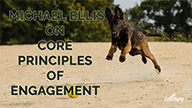A History of Guide Dogs
Ed's Note: Daniel Jacob is a writer and guide dog expert who lives in Montreal, Canada. He often writes from his perspective of being a blind man navigating the world with his guide dog.

We all know the ancient Romans left an incredible legacy in the development of art, language, literature, technology, and more. But who knew their culture also played a role in the history of guide dogs? There is evidence that people with vision loss have been working with canine companions, protectors, and guides for centuries.
The earliest recorded example of the guide dog and human bond comes from the Roman city of Herculaneum (now located in present-day Italy), which was buried along with Pompeii in AD 79. Herculaneum's ruins, still being unearthed today, contain a mural showing a blind figure being unmistakably guided by a dog. The Middle Ages offer us a similar record—in the form of a wooden plaque—depicting a blind man being guided by a dog on a leash.
The first known attempt to train guide dogs happened at a hospital for the blind in Paris in 1780. And in 1788, a blind sieve-maker in Vienna was said to have trained a dog so effectively for his own use that people thought he was sighted.
In the 19th century, the concept of guide dog training finally made it into print. Johann Wilhelm Klein, the founder of a school for the blind in Vienna, wrote an 1819 textbook that describes the training of a guide dog using a rigid leash, although no one knows whether his theories were ever used.
The modern guide dog movement, however, began with one remarkable German Shepherd (whose name seems to be lost in the annals of history) in the early 1900s.
Wartime Heroes on Four Legs
The story begins during World War I when thousands of soldiers lost their sight (usually because of poison gas). One day, a German doctor named Gerhard Stalling was walking the grounds of a veterans' hospital with a patient who had lost his vision. Called away suddenly, Stalling left his German Shepherd with the man to keep him company. When he came back, he got the distinct feeling his dog was trying to help the man, and Stalling was impressed. By 1916, Stalling had opened the world's first guide dog school, and soon there were branches all over Germany.
Some accounts state the school matched dogs to several people all around the world. Unfortunately, Stalling's facility shut down within a decade, but in 1923, another large school opened in Potsdam, near Berlin. And it was this school that attracted the interest of Dorothy Harrison Eustis, a wealthy American who was training and breeding dogs for the customs service, army, and police in Switzerland. Eustis spent several months studying at the Potsdam school and wrote about it in an article for the Saturday Evening Post, published in the United States in 1927. Little did she know, she was setting the groundwork for bringing great joy and independence—on a large scale—to people with vision loss all over the world.
Guide Dogs Abroad
Morris Frank, a young blind man living in Nashville, Tennessee heard the article and wrote to Ms. Eustis asking her to train a dog for him. Morris Frank had lost the use of his eyes in two separate accidents and did not like depending on others. He asked Ms. Eustis to train a dog for him and, in return, he would teach others who were blind so that they, too, could become independent.
Ms. Eustis replied that if he could come to Switzerland for the training, she would accommodate his request. Morris Frank became the first American to use a dog guide and Buddy, a female German Shepherd, became the pioneer dog guide in America.
Morris Frank returned home to Nashville and honored his promise. With $10,000 from Ms. Eustis, Morris Frank worked to establish the first dog guide school in America. Incorporated on January 29, 1929, it was called The Seeing Eye, after the article Ms. Eustis wrote. The title came from Proverbs 20:12 in the Bible, "The seeing eye, the hearing ear; The Lord hath made them both."
The first class had two students and by the end of the first year, 17 people experienced newfound freedom with Seeing Eye dogs by their sides. By 1931, it became evident that the Nashville weather was not conducive to year-round training and the school relocated to New Jersey. Eustis also founded a guide-dog school in Switzerland and went on to travel and lecture widely about her work. She published another article in Britain, attracting the attention of Muriel Crooke and Rosamond Bond, who started the first guide dog school there in 1931.
Over the next few decades, schools sprung up all over the world, bringing guide dogs to many grateful handlers, including many veterans who lost their sight in World War II. Millions of people in the United Kingdom were introduced to the idea of guide dogs in 1965 when a guide dog named “Honey” became the subject of a popular BBC children's television show. Viewers followed Honey through her training and collected donations of aluminum foil to fundraise for the dog's education.
American horror and suspense novelist, Dean Koontz, owns a retired guide dog named “Trixie Koontz.” The bestselling author even published one of his books, Life is Good: Lessons in Joyful Living, using Trixie Koontz as a pseudonym in 2004.
Two heroic dogs brought their handlers to safety after hijacked airplanes struck the World Trade Center on September 11, despite working in the noisiest, dangerous, and chaotic conditions imaginable. Omar Riviera and his yellow Labrador retriever “Dorado” climbed down 70 stories just before tower one collapsed. Riviera even tried to release Dorado so the dog could have a better chance at survival but found the dog would not leave his side.
Another dog, “Roselle,” led handler Michael Hingson down 78 stories in the same building. Michael Hingson wrote about this in great detail in his book Thunder Dog: The True Story of a Blind Man, His Guide Dog, and the Triumph of Trust.
Guide Dogs Today
Guide dogs are working all over the world. Today, there are 10,000 dog and handler teams in North America alone. These guide dogs are helping people who have many different disabilities, acting as hearing dogs for people who are deaf or hard of hearing, retrieving items, operating light switches, and opening doors for people with mobility issues. Assistance dogs can even help with seizure response, psychological illnesses, and autism.
Countless people through history have been transformed by the special relationship that a guide dog provides and the freedom it allows them. Man's best friend? We think so and, in more ways, than one. In several countries, guide dogs, along with most service and hearing dogs, are exempt from regulations against the presence of animals in places such as restaurants and public transportation.
Laws and regulations vary worldwide. In the United States, the Americans with Disabilities Act (1990) prohibits any business, government agency, or other organization that provides access to the general public from barring guide dogs. However, religious organizations are not required to provide such access. The Fair Housing Act requires that landlords allow tenants to have guide dogs in residences that normally have a No Pets policy and no extra fees may be charged for such tenants. Whether guide dogs in training have the same rights or not usually falls on each state government.
In most South American countries including Mexico, guide dog access depends solely upon the goodwill of the owner or manager. In more tourist-heavy areas, guide dogs are generally welcomed without problems. In Brazil, however, a 2006 federal decree requires the allowance of guide dogs in all public places. The Brasília Metro has developed a program that trains guide dogs to ride it.
In Europe, the situation varies. Some countries have laws that govern the entire country and sometimes the decision is left up to the respective regions. In Australia, the Disability Discrimination Act (1992) protects guide dog handlers. Each state and territory has its laws, which may differ slightly.
In Canada, guide dogs are allowed anywhere that the general public is allowed.
In South Korea, it is illegal to deny access to guide dogs in any areas that are open to the public. Violators are fined no more than 2 million won ($1,600 USD).
In Islam, dogs are considered to be unclean. Many Muslim taxi drivers and store owners have refused to accommodate customers who have guide dogs. In 2003, the Sharia Council (based in the UK), ruled that the ban does not apply to dogs used for guide work. Unfortunately, many Muslims continue to refuse access and see the pressure to allow the dogs as a restraint upon religious liberty. Sheikh Ibrahim Mogra of the Muslim Council of Britain has argued strongly that Sharia does not preclude working with guide dogs and that it is a duty under Sharia for a Muslim to help the visually impaired.
In Australia and New Zealand, the visually impaired are encouraged to use a cane along with their furry friend. Why? Across the world, blindness is indicated by the white cane, not the dog. The second most important reason why a cane would be encouraged is that, while a dog will stop at a step or obstacle, it will not tell you what that obstacle is; the sound of the cane rapping on it, however, will.







Ask Cindy.